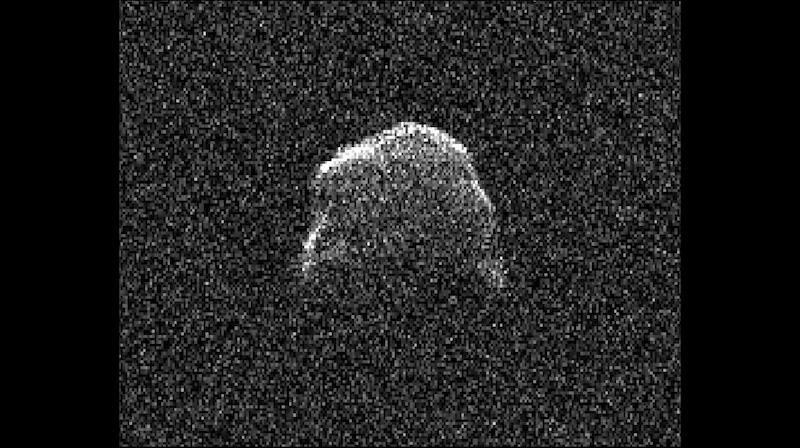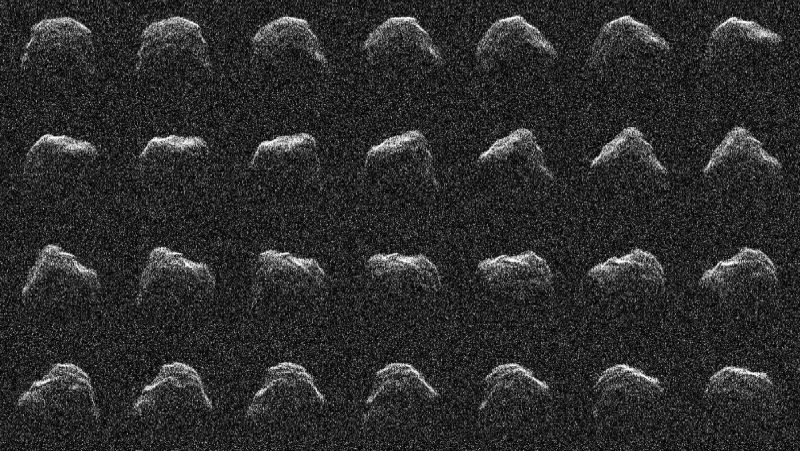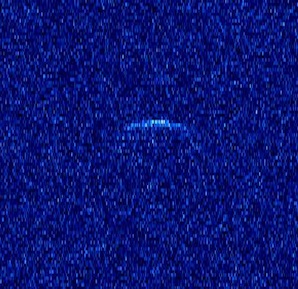1,001st near-Earth asteroid
The video above shows asteroid 2016 AJ193 rotating as it swept past Earth. NASA’s Goldstone’s 70-meter (230-foot) antenna acquired the images on August 22, 2021. This object thus became the 1,001st near-Earth asteroid to be measured by planetary radar since the first radar observation of asteroid 1566 Icarus in 1968. The huge space rock safely passed closest to Earth on August 21. Although we were never in danger, asteroid 2016 AJ193 passed close enough to be seen in backyard telescopes.
Meanwhile, from August 20 to 24, scientists studied the rock with the Goldstone antenna near Barstow, California. They sent radio signals to the asteroid and analyzed the radar reflections or “echoes” that returned. Scientists found that asteroid 2016 AJ193 completes a rotation every 3.5 hours. They also were able to acquire good details of the object’s surface, including ridges, small hills, flat areas, concavities, and possible boulders, NASA said.
Asteroid 2016 AJ193 is about 0.9 miles (1.4 km) in diameter. It’s travelling at 58,538 miles per hour (94,208 km/h) relative to Earth. It safely passed by Earth at a distance of 2.1 million miles (3.4 million km) or some 8.9 times the moon’s distance from us on August 21.
Astronomer Shantanu Naidu of NASA’s Jet Propulsion Laboratory (JPL) in Pasadena, California, led the August 22 radar observations of 2016 AJ193. He commented in a NASA statement that scientists planned radar observations of this asteroid for years. He said:
It has a cometary orbit, which suggests that it may be an inactive comet. But we knew little about it before this pass, other than its size and how much sunlight its surface reflects.

Planetary defense
NASA said that nearly 3/4 of all near-Earth asteroid radar observations have been made since the agency’s NEO Observations Program increased funding for this work 10 years ago. The program is now a part of NASA’s Planetary Defense Program. It said the 1,000th asteroid to be observed with radar was 2021 PJ1 on August 14, 2021. That newly discovered small near-Earth asteroid passed us at a distance of over 1 million miles (about 1.7 million km). Between 65 and 100 feet (20 and 30 meters) wide, 2021 PJ1 wasn’t a threat to Earth, either. But this asteroid’s approach was historic, NASA said:
… Marking the 1,000th near-Earth asteroid to be observed by planetary radar in just over 50 years.
Astronomer Lance Benner, who leads leads NASA’s asteroid radar research program at JPL, said:
2021 PJ1 is a small asteroid, so when it passed us at a distance of over a million miles, we couldn’t obtain detailed radar imagery. Yet even at that distance, planetary radar is powerful enough to detect it and measure its velocity to a very high precision, which improved our knowledge of its future motion substantially.

Asteroid radar research
Improving knowledge of future motion is one of the main points of NASA’s asteroid radar research program. In recent decades, astronomers have realized that asteroids and comets do have the potential to strike Earth. NASA said that scientists will use the new observations of 2016 AJ193 to better understand its size, shape, and composition. As with 2021 PJ1, measurements of its distance and speed during this approach also provided data that will reduce uncertainties in computing its future orbit. Kelly Fast of the Planetary Defense Coordination Office at NASA Headquarters in Washington D.C. commented:
Surveys have used ground- and space-based optical telescopes to detect and track nearly 27,000 NEOs throughout our solar system. In addition, planetary radar is an important tool for monitoring asteroids that come close to Earth. Reaching this milestone of now just over 1,000 radar detections of near-Earth asteroids emphasizes the important contribution that has been made in characterizing this hazardous population. That is fundamental for our planetary defense efforts.

Bottom line: On August 22, 2021, asteroid 2016 AJ193 became the 1,001st near-Earth asteroid to be measured by planetary radar since the first radar observation of asteroid 1566 Icarus in 1968.











